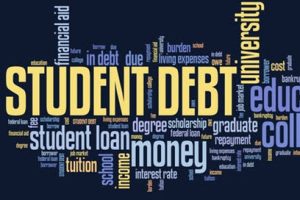Biden Forgives Additional Student Loans

The administration says that retooling the Public Service Loan Forgiveness initiative will forgive an additional $1.7 billion in student debt. That figure would bring the running total to $11 billion.
This program began in 2007. However, mostly because of strict eligibility requirements, only about 2 percent of applicants qualified for student loan forgiveness. The changes are “real and significant,” insisted Federal Student Aid chief Richard Cordray. “Our new approach will add months or years of service credit for huge numbers of student loan borrowers by counting certain payments that had been ineligible. In some cases, borrowers will earn full loan forgiveness based on the changes,” he added.
Borrowers must submit their applications by October 31, 2022 to take full advantage of the new PSLF.
Student Loan Statistics
$11 billion is a lot of money. Yet in terms of student loans, this number is a drop in the bucket. Student loan borrowers owe a staggering $1.6 trillion. Some advocates and economists have repeatedly urged the President to cancel most or all of this debt.
But the total loan balance statistics, which are frequently cited in the media, may be a bit misleading. The average graduate owes about $40,000. That figure could prompt postponement of large purchases, like houses. However, the average college graduate earns about $55,000 a year. Therefore, from a statistical standpoint, there are people who need financial help worse than student loan borrowers, at least according to some.
There are other financial numbers to consider as well. The government just spent a lot of money on coronavirus stimulus packages, as well as an infrastructure package. These expenses were arguably necessary. But because of them, many people in Washington are not in the mood to write another big check.
Bankruptcy and Student Loans
The bottom line is that the President will probably not forgive a significant amount of student debt anytime soon. Fortunately, student loan forgiveness is already available through consumer bankruptcy.
In terms of bankruptcy law, student loans are priority unsecured debts. Like other obligations in this category, such as past-due income taxes, student loans are only forgivable in certain situations. The discharge rules in Indiana and Illinois for Chicago bankruptcy lawyers are:
- The debtor must have made a good faith effort to pay the loans,
- Making the payments would cause the debtor’s income to drop below the poverty line, and
- The debtor must have a long-term disability which prevents payment.
If courts strictly interpret this rule, which is called the Brunner Rule, almost no one qualifies for student loan forgiveness. However, due to the magnitude of the student debt crisis, most judges no longer strictly interpret the Brunner Rule.
As a result, most debtors who request student loan forgiveness in bankruptcy receive at least a partial discharge. That’s especially true if, and this is normally the case, a judge refers the student loan dispute to mediation.
During mediation, each side has a legal duty to negotiate in good faith. So, the lender must be willing to compromise and reach an agreement. That compromise almost always involves partial student loan forgiveness. As a result, many debtors see their payments drop significantly.
Bankruptcy has other benefits for distressed student loan debtors. For example, the Automatic Stay stops wage garnishment and other adverse creditor actions. Section 362 of the Bankruptcy Code applies even if the underlying debt is nondischargeable.
Contact Hard-Working Cook County Lawyers
No matter what kind of financial problem you are having, bankruptcy could be a way out. For a free consultation with an experienced Chicago bankruptcy lawyer, contact the Bentz Holguin Law Firm, LLC. We routinely handle matters in Illinois and Indiana.
Resource:
fortune.com/education/business/articles/2021/12/06/biden-is-revamping-public-service-loan-forgiveness-heres-when-those-student-loans-will-get-erased/


